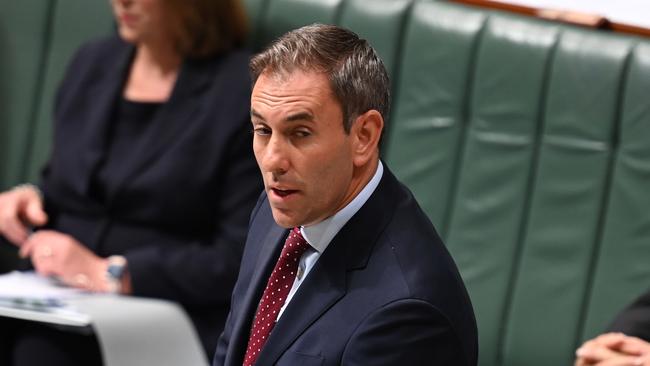Frontline workers will be long-term losers under Labor’s tax cuts
Sparkies, paramedics and police officers will be long-term losers under stage 3 changes, as a major credit ratings agency warned Labor’s revamped tax cuts could be more inflationary.

Sparkies, paramedics, police officers and accountants will be long-term losers under Labor’s stage three tax changes, as a major credit rating agency says Anthony Albanese’s revamped tax cuts will likely be more inflationary than Scott Morrison’s original plan.
Under Labor’s tax changes, electricians, school principals, cops, train drivers and others will pay more tax under the proposed legislation in a decade, analysis by The Australian has revealed.
Bigger tax cuts for middle-income earners promoted by the Prime Minister and Jim Chalmers are projected to erode over time as bracket creep captures more Australians under a higher 37c tax rate. In 10 years, Australians earning the equivalent of more than $104,000 today will be worse off under Labor’s redistribution of the tax relief.
That leaves a wide pool of Australians, including essential workers, winning in the short term but having less money in their pockets in the future as their average tax rates push higher.
Ahead of Treasury secretary Steven Kennedy being grilled at Senate estimates on Wednesday, an S&P Global report said while Labor’s tax cuts would have a “broadly neutral” impact on the budget, they could be more inflationary than the Morrison government’s stage three.
“They may … be marginally more inflationary than the original tax cuts since they will provide additional funds to low- and middle-income earners,” the report, which provided an annual review of Australia’s economy and budget position, said.
The Australian can reveal school principals will be among the first to begin paying more under Labor’s plan.
A year after the introduction of the modified stage three, principals’ average incomes are expected to creep above the $146,486 annual salary threshold separating winners and losers.
By 2033-34, those earning more than $104,000 today – assuming 3.5pc annual wage growth – will leave a much wider pool of Australians, including essential workers, with less money in their pocket.
In the middle of 2027, electrical engineers, tram and train drivers will be left out of pocket as they become what Labor believes are high earners. By the end of this decade construction managers are among the occupations who will earn too much to be beneficiaries of the tax changes.
Two years later, police and crane operators will be worse off as their average taxable incomes push towards $150,000 a year. That will be followed by accountants and vets from 2032, while fire or emergency service workers, paramedics, and electricians will be worse off from mid-2033.
In a speech to parliament last week, the Treasurer said Labor’s changes meant “more tax relief for more workers, to help with the costs of living”.
“The truckies, the nurses, the police officers will get a bigger tax cut. This is all about supporting the hard work of people who make our economy and our country strong,” Dr Chalmers said.
Coalition senators will probe Dr Kennedy and senior Treasury officials on Wednesday about the timing of the government’s stage three advice.
The S&P report, which flags slower economic growth this year amid a high interest rate environment, says “we expect continued surpluses over the next three years, a few years longer than we previously thought, before they turn into a deficit”.
While deficit and debt levels are expected to be modest over the next two years, S&P Global’s “downside scenario” warned that economic headwinds could negatively impact Australia’s AAA credit rating. “We could lower our ratings if the general government deficit widened materially, causing net debt and interest costs to rise. This could occur if the economic outlook or commodity prices weakened relative to our expectations, causing fiscal outcomes to materially perform below our forecasts.”
S&P, which did not reaffirm the country’s top credit score, forecasts real GDP growth will slow to 1.2 per cent this year but fiscal accounts will remain strong thanks to the “tailwinds from low unemployment, elevated commodity prices, and high nominal GDP growth”.
Dr Chalmers said the ratings agency had “praised our strong budget outcomes and endorsed the government’s budget strategy”.
“The report makes it clear that despite the challenges confronting us, our government is doing better than other countries’ when it comes to budget repair to help insulate ourselves against global uncertainty,” he said.
“Australia is one of only nine countries to be rated AAA by all three major credit rating agencies … our strong credit rating means Australia can access funds at lower rates.”
AMP Capital chief economist Shane Oliver last week warned that only the top 20 per cent of income earners – those earning above $106,000-a-year – pay more tax than they receive in government benefits including childcare and rent subsidies.
Workers on $180,000 or more represent the top 3.6 per cent of income earners but pay nearly a third of income tax, while the top 10 per cent of earners pay half.





To join the conversation, please log in. Don't have an account? Register
Join the conversation, you are commenting as Logout